Book Reviews: Field Guides
For ease of browsing, we've divided our book reviews into two sections. Below you'll find our reviews of field guides to birds – books that aid in the identification of birds. For books that go beyond identification, and beyond birds, see our page of Book Reviews: Natural History.
Field Guide Reviews
#1: Lone Pine's field guide to the Birds of Northern California
#2: A modern photographic field guide from Princeton University Press: Birds of Western North America
#3: National Geographic, 6th Edition: Scott's review of a classic field guide's latest incarnation
#4: The most complete photographic field guide: The "Big" Stokes, reviewed by Don
#5: Compact, cheap, local: Birds of Napa County
#6: The eagerly awaited second edition of the Sibley Guide to Birds
#7: An excellent guide to the birds in your backyard: National Geographic Backyard
#8: Sibley for the casual birdwatcher: Western Backyard Birds, the Poster
#9: The most local folding guide: the Laws Pocket Guide to Backyard Birds of the Bay Area
#10: Two new photographic guides just for California go head to head
#11: A new-old challenger on the "local birds folding guide" front: Sibley's Backyard Birds
7/19/16: Sibley's Backyard Birds of Northern California
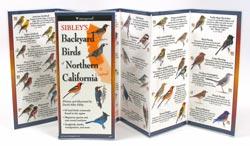 In 2014, we were happy to introduce you to the Laws Pocket Guide to Yard and Garden Birds of the San Francisco Bay Area. At the time, we recognized this as by far the best simple folding guide to local birds, with a species selection that was highly accurate for our area, good illustrations, and a helpful organization and text. In 2015, however, it promptly received some competition from the biggest name in bird guides, David Allen Sibley. Now that we’ve carried Sibley’s Backyard Birds of Northern & Central California for some time, we’re in a position to state that while both guides are quite good and will successfully identify almost all the birds you see in your yard, there are a few distinguishing features that might steer you towards one or the other.
In 2014, we were happy to introduce you to the Laws Pocket Guide to Yard and Garden Birds of the San Francisco Bay Area. At the time, we recognized this as by far the best simple folding guide to local birds, with a species selection that was highly accurate for our area, good illustrations, and a helpful organization and text. In 2015, however, it promptly received some competition from the biggest name in bird guides, David Allen Sibley. Now that we’ve carried Sibley’s Backyard Birds of Northern & Central California for some time, we’re in a position to state that while both guides are quite good and will successfully identify almost all the birds you see in your yard, there are a few distinguishing features that might steer you towards one or the other.
Illustrations: While John Muir Laws is a very talented artist, his drawings can sometimes seem a little more hastily done, with colors or shapes just slightly off from what one would expect for a given bird. His pictures are much better than previously available guides, but Sibley is the top bird artist in America and spent many years painstakingly illustrating every bird in North America for his magnum opus, the Sibley Guide to Birds. Every one of Sibley’s paintings is remarkably faithful in capturing the shape and character of its species. Advantage Sibley.
Text: While Sibley is a tremendously knowledgeable birder, this folding guide does not unfortunately reproduce all that knowledge in the most locally relevant form. Although it accurately bears his name, the text seems to have been simply extracted from his larger, North American-wide guide. Some details may be true elsewhere, but are not accurate here: Bewick’s wrens won’t be found in mesquite thickets, song sparrows are uncommon in most “gardens and hedges,” the commonness of the various woodpeckers is different than indicated, etc. In contrast, the Laws guide was obviously written by a true local and provides a compressed but insightful commentary. Advantage Laws.
Species selection: Both pretty good! The Laws guide includes a few more species than Sibley does (our three most common owls, our woodland vireos—common, but usually unseen by casual backyard birdwatchers, and local specialties like red-masked parakeet—the “parrot of Telegraph Hill”). On the other hand, trimming 20 species or so less common species arguably results in an easier to use, more streamlined guide. Laws has more birds, but Sibley has all the truly common “backyard birds.” Toss-up.
Organization and format: The Sibley guide comes in the most familiar form for works of this genre, six laminated panels that unfold in one direction, accordion-style. This is easy to handle and lends itself to neatly divided panels with plenty of white space and easy readability. The Laws guide is rather more innovative, folding like a map to make two big surfaces on the front and the back. Although not laminated, it is printed on a synthetic, tear-proof paper. This allows a flexible color-based arrangement and a general indication of relative size (Sibley has six or seven birds per panel, whether they are big birds or small). If you are a color-oriented thinker, Law’s arrangement may be appealing, but most people are able to deal with the family-based organization of Sibley fairly intuitively, at least when limited to this smaller number of species. And overall, the Sibley guide feels substantially less cluttered and easier to glance through, probably the primary consideration for a backyard bird guide. Slight advantage Sibley.
- Go to the index of book reviews -
11/10/15: Two New Photographic Guides to California Birds
For many years, most serious birdwatchers would recommend field guides with illustrations over guides with photographs largely because available photos just weren’t good enough. Many species (particularly birds in flight) were only depicted in poor quality images that lacked detail, were poorly lit, didn’t capture the bird in the right position to show important field marks, and just didn’t look very good. More recently, however, an abundance of excellent bird photographers and the huge libraries of digital images now available have led to a new crop of bird books, with several high-quality, comprehensive photographic guides released in recent from the Stokes, National Wildlife Federation, and Princeton University Press. 2015 has seen the next step in this process, as regionally-focused guides become available that pair top-notch modern photographs with a more limited selection of birds for those of us who don’t need a full continent, 1000+ species guide. 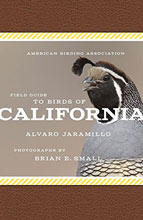
For us in the Bay Area, there are two new books competing for our favor. The first is the American Birding Association’s Field Guide to Birds of California by Alvaro Jaramillo of the San Francisco Bay Bird Observatory with photographs by Brian E. Small. Part of an ambitious ABA project to publish guides to every state in the country, the book adopts a modern, streamlined aesthetic by the design team of Scott & Nix, publishers most well-known for their work on Sibley’s Guide to Birds (2nd edition), Guide to Trees, and poster series. The results are quite beautiful: faux-leather cover, big sharp photos, and a slimmed down text with lots of clean surrounding white space make for one of the most attractive field guides around. The elegant layout contributes to a superior armchair birding experience—it’s a very nice book to sit down and look through.
As a practical field guide, it does have a few shortcomings, among several positives. Foremost among the good news is the project’s announced intention to appeal mainly to beginning and intermediate birders with a selection of 308 species (almost all regular California birds but few rarities). This is good—the biggest factor in making a guide difficult to use is to have too many or too few birds. This is the right number for most people interested primarily in local birds. The text is pleasantly readable compared to some big guides, with a simple paragraph of readable prose taking the place of the usual mass of formulaic information (i.e. sections for “range,” “habitat,” “description,” “voice,” “habits” or the like). And the amount of information is generally appropriate for the intended audience. This streamlined format, however, does mean the exclusion of some common features that are useful. Most prominently absent are range maps, presumably thought unnecessary in a one-state guide. In practice, they get replaced by words, however, which are less instantly digestible if you want to know at a glance if a bird is found where you are.
Maybe the biggest mark against this book’s ease of use by relatively inexperienced birders is the limited means of finding a bird. Arranged taxonomically, rather than by an easily-misleading color-based scheme, the book features a standard “quick index” to bird families (“sparrows,” “jays,” etc.). But that is it for navigational handicaps. If you don’t know the bird families yet, you will need to flip through the pictures till you spot it. Useful additions in this regard found in other books might include a simple illustrated index of families and cross-references to similar species (i.e. “this bird could be confused with this other bird on page 214”). To be fair, this is no worse than many other guides, and the well-defined species selection alone will help beginners, but compared to books of similar ambition the navigational infrastructure is a bit sparse. 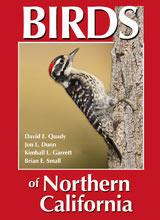
The second new book is Birds of Northern California by David E. Quady, Jon L. Dunn, Kimball L. Garrett, and Brian E. Small. (Yes, both books heavily feature photography by Brian Small—including some of the same images. This book contains nearly 200 by other photographers as well.) Although the geographic range is smaller (Monterey and northwards), the species count is somewhat larger (400+ species vs. 308). In practice, the level of comprehensiveness is very similar between the two books, with many of the additional species here separated in shorter accounts across three sections in the back on “Mountain Specialties,” “Northern Mojave Desert/Great Basin Specialties,” and “Pelagic Specialties.” This is mostly a good thing for us: similar species found outside of the main area don’t clutter and confuse, with Gambel’s Quail and Ladder-backed Woodpeckers relegated to the rear to avoid confusion with our northern California Quail and Nuttall’s Woodpeckers. If you are actually using this guide in those specialty areas, however, you might find the division less helpful, since some relevant birds remain in the main text.
Overall, we give that organizational innovation a thumbs-up. This volume also includes that very useful feature missing from the ABA book: “similar species” tips with page references to the other possible candidates. A short index is found inside the back and a useful color-coded table of contents is found right inside the front. Birds of Northern California makes another attempt at innovation in a selection of 40 “common local birds” compactly illustrated at the beginning of the book. This is also a good idea that will help some beginners, although the execution could have been significantly better with a more organized presentation and better selection of species. Still, it gets a lot of them! The net result is several different ways to find your way in this book, which is only to the benefit of different users.
The species accounts themselves are also well-done. Despite a compact, pocketable size, photos are typically given enough room for full- or half-page reproductions and are sharp, useful, and attractive. The text veers somewhat towards wordiness and overdensity (the authors here also chose to replace range maps with a mass of dense text), but for the most part stays useful and readable while successfully avoiding an excess of technical language. A few lines allocated for notes on your own sightings combine with a checkmarkable index to make this a good book in which California-only birders can keep their life lists. In addition to the beginner’s favorite “similar species” feature, the text generously covers the usual territory: description, voice, behavior, range, and interesting tidbits.
Verdict: Both books are worthy additions to California birdwatchers’ choices and are great new options for those who would like a more manageable selection of local species only in their bird book. Both feature beautiful large format photographs (in fact, mostly by the same photographer) but have some differences in their text and organization. The ABA Field Guide to Birds of California by Alvaro Jaramillo is beautifully designed for armchair birding and casually interested birders who prefer a brief, simple text that reads more like a friendly guide’s advice than a reference book. Birds of Northern California by Quady, Dunn, Garrett, and Small is a bit more comprehensive, with more birds, more photos, more text, and more tools for finding and comparing different species. More serious birders will probably find many of these features useful, while casual users may be perfectly well satisfied with the streamlined work of art that is the ABA Birds of California.
- Go to the index of book reviews -
11/20/14: Laws Pocket Guide to Bay Area Backyard Birds
Laws Pocket Guide: Yard and Garden Birds of the San Francisco Bay Area
John Muir Laws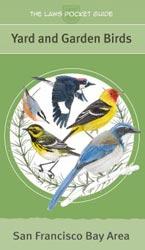 This is the one we’ve been waiting for: an inexpensive fold-out guide that simply and accurately shows you our common neighborhood birds. There have been numerous attempts at this much-needed item over the years, but all have been plagued by inaccuracy, incompleteness, or inadequate illustrations. Unlike those, this new guide by John Muir Laws of the California Academy of Sciences was actually authored by a local naturalist who knows what birds are here. It is made to cover the Bay Area—not “North America,” “the West,” or even “California”—and it delivers a species selection that is comprehensive for anything you are likely to see in your yard or around your neighborhood (with the one exception of the missing Hooded Oriole. We’re not sure how he missed out, but given our past experience, having only one missing notable bird is tremendous progress.) At the same time, it avoids the equally common pitfall of being filled with rare or non-local birds that clutter and confuse—everything here can be seen within the greater Bay Area.
This is the one we’ve been waiting for: an inexpensive fold-out guide that simply and accurately shows you our common neighborhood birds. There have been numerous attempts at this much-needed item over the years, but all have been plagued by inaccuracy, incompleteness, or inadequate illustrations. Unlike those, this new guide by John Muir Laws of the California Academy of Sciences was actually authored by a local naturalist who knows what birds are here. It is made to cover the Bay Area—not “North America,” “the West,” or even “California”—and it delivers a species selection that is comprehensive for anything you are likely to see in your yard or around your neighborhood (with the one exception of the missing Hooded Oriole. We’re not sure how he missed out, but given our past experience, having only one missing notable bird is tremendous progress.) At the same time, it avoids the equally common pitfall of being filled with rare or non-local birds that clutter and confuse—everything here can be seen within the greater Bay Area.
The guide is published by the non-profit Heyday Books of Berkeley and is printed in California on tear-proof synthetic paper. Folding into a compact pocket size, you simply pop it open for a quick overview of birds laid out by color, with sensible and intuitive sub-groupings by bird family (i.e. the woodpeckers are together, the swallows are together). It’s the same eminently logical middle ground of usability and biological meaningfulness that has made the artist’s Laws Field Guide to the Sierra Nevada such an indispensable guide to the natural history of the mountain range. Every year another big fancy guide to North American birds is released, each trying to top its predecessors in heft and comprehensiveness (1000+ species! 7000 paintings!). But if you want to learn a language, you don’t just pick up a 70,000 entry dictionary and start reading.
The way to learn German, is, to read the same dozen pages over and over a hundred times, till you know every word and particle in them, and can pronounce and repeat them by heart.
- Emerson, “Power”
Well, maybe not quite. But we do believe that the best way to learn birds is to start with the local birds, the common ones that you can easily see on your feeders or out your window on any day you choose to look. Get to know a majority of the hundred or so species in this guide and you will find that you suddenly and painlessly have a grasp of bird families, of similarities of shape and behavior, of migration and residence. Nature can sometimes seem like the province of devoted hobbyists, with a firm divide between birders’ jargon and the speech of normal people. But the names of the birds in our yards aren’t actually a foreign tongue, learned by painful rote over the course of years. Their names are part of our own language, our own everyday speech. And this is a guide that makes learning those names feel as natural and intuitive as it should be.
Also available: the so-called Laws Pocket Guide to the Birds of the Sacramento Valley is actually an excellent guide to the waterfowl, shorebirds, and wading birds found around Marin and Sonoma's ponds and tidal marshes. So if you want to go beyond your yard and identify the ducks over at Las Gallinas, for example, this will fit the bill nicely.
- Go to the index of book reviews -
9/14/14: Sibley's Backyard Birds Poster
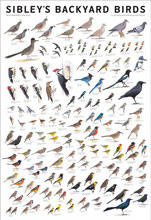 Sibley’ Backyard Birds of Western North America
Sibley’ Backyard Birds of Western North America
David Allen Sibley
This isn’t quite a book. It’s a 24x36 inch poster featuring the artwork of David Allen Sibley, more or less universally considered the preeminent bird artist of modern times. Sibley catapulted himself to the front ranks of bird book authors with his comprehensive field guides to American birds; this poster and its companions make those illustrations available in a more streamlined format for those who don’t need a 600 page tome. Instead, this poster illustrates about 100 of the bird species most commonly seen in western backyards and serves as an excellent quick guide for our region.
What’s left out in turning a book into a poster? Limited space necessitates a limited scope of coverage, excluding eastern species, shorebirds, waterfowl, and raptors to focus on the songbirds one will more frequently encounter around one’s home (other posters are available for waterfowl, raptors, and hummingbirds). Descriptive text is minimal compared to a field guide—you get the name of each bird (common and scientific), and that’s it. In general, if the name is all you want to know, that’s fine. Occasionally, if used as an exclusive reference, you might run into some confusion between similar species that would be easily distinguished by the range maps in a book (for example, the similar looking but not locally present Canyon Towhee and Juniper Titmouse are shown alongside our California Towhee and Oak Titmouse), but this is a small problem and one easily avoided by using in conjunction with another book, the internet, or the friendly advisors at your local wild bird store.
What you get, though, is still impressive for a single sheet of paper. Each species gets from one to four images, showing male/female/immature/non-breeding birds as needed—in short, whatever plumages are necessary to identify the birds in your yard. And the poster format has some inherent advantages. Fast comparisons are easy; if you favor a “flip through the book until you see your bird” approach then the poster format is ideal. At the same time, similar species are clustered together, making biological groups if anything more clear and comparisons easier (for example, all of our woodpeckers can be compared at a glance). Freed from the small pages of the book, all the birds can be shown to scale relative to each other, enabling at-a-glance comparisons of size. This means that even with 100 species in the poster, the larger birds (pileated woodpecker, crow, etc.) are substantially larger than they appear in the book.
What does it mean to say Sibley’s pictures are the best? Partially, it is a recognition of the overall scope of his achievement—he illustrated all the birds, in a uniform style that makes using them for identification consistent, familiar, and easy. As technical bird illustrations they’re pretty well unmatched: you can trust Sibley to give you the details you need. If there’s an important field mark, it’s in there (unlike with a given photo). If you need to compare two similar species, you can trust his illustrations to make the difference clear. Sibley’s paintings also include clever hints of habits and habitats: most ground-feeding birds are on the ground, robins are on a lawn, nuthatches are headed head first down a tree limb, sapsuckers have drilled their characteristic rows of holes, and acorn woodpeckers guard their stash of acorns. These touches help to raise the poster above mere technical illustration—it’s also an artistically pleasant portrait gallery of our local characters. The production of the poster does justice to the artwork, with sharp, crisp images printed in the USA on high quality paper.
Companion large format raptors and waterfowl posters are also available, as well as a smaller hummingbirds poster.
6/18/14: Nat Geo Backyard
National Geographic Guide to the Backyard Birds of North America
Jonathan Alderfer and Paul Hess The National Geographic Field Guide to the Birds of North America is one of the most popular comprehensive guides to identifying American birds. For someone who just wants to learn the birds in their backyard, however, “comprehensive” may not be the most desirable characteristic: the full size guide contains nearly a thousand bird species, including the full selection of shorebirds, waterfowl, and three-times-a-year visitors to the Aleutian Islands. Much easier to use is Nat Geo Backyard (as we’ll call it for brevity’s sake—a 19 syllable title goes rather against the less is more philosophy promoted by the book), whose 150 species do an excellent job of covering the birds you will actually see in your yard.
The National Geographic Field Guide to the Birds of North America is one of the most popular comprehensive guides to identifying American birds. For someone who just wants to learn the birds in their backyard, however, “comprehensive” may not be the most desirable characteristic: the full size guide contains nearly a thousand bird species, including the full selection of shorebirds, waterfowl, and three-times-a-year visitors to the Aleutian Islands. Much easier to use is Nat Geo Backyard (as we’ll call it for brevity’s sake—a 19 syllable title goes rather against the less is more philosophy promoted by the book), whose 150 species do an excellent job of covering the birds you will actually see in your yard.
In short: this is the most usable, beginner-friendly book we’ve seen. The first stumbling block for an introductory guide usually involves the question of organization. Should birds be arranged as they are in the full size guides, by family and evolutionary relatedness? Or by some combination of size and color, to make things easier if you don’t know a finch from a flycatcher? Nat Geo Backyard has a pragmatic solution: do both, plus add a few other ways of finding the bird you want.
- While the birds are arranged in the official taxonomic order (i.e. all the hawks together, later all the hummingbirds together, sparrows and then finches together near the end, etc.), there is also…
- A color-based, illustrated index in the first pages of the books (i.e. all the red birds shown together).
- Additionally, there is a nice quick-find index on the front cover flap (“hummingbirds” on page x, “jays” on page y), followed by…
- A full visual index on the two inside covers showing all 150 birds in small illustrations, laid out at a glance for “look-through-the-pictures-until-you-see-it type users.”
- Finally, the main species accounts have nice cross-referenced “similar species” accounts to guide you to the relevant alternatives when there is a possibility of confusion.
Five ways to find a bird? Amazing!
The other advantage of limiting the species account, beyond simplifying the identification process, is that there is more space for interesting stuff—coverage that is deeper rather than broad and shallow. After all, the essence of backyard birdwatching is not accumulating the most species (you generally leave your house if you want to see some shorebirds), but in spending time with the bread and butter of the bird world. Each bird gets a whole page or two, filled not just with the standard bare bones of identification, but also stocked with extra info such as:
- A few lines of nice, introductory prose about each bird: Steller’s Jays are raucous, inquisitive jays of Western forests. They frequently interact with people in backyards, campgrounds, picnic areas, and anywhere else they can expect (or demand) a handout.
- “Similar species” tips
- Full coverage of visual identification, voice description, range, and habitat
- Food and feeding—including whether they can be attracted to feeders
- Nesting—including whether they can be attracted to houses, plus nice reference material on questions like where do they build their nest? How many babies do they have? How long until they fledge?
More good reading, rather than just typical reference, continues beyond the species accounts. The introduction contains generally solid information about attracting birds with feeders, houses, and birdbaths (except that you can’t trust your standard tube feeder to exclude squirrels—I’m not sure what Mr. Hess was thinking there). Then, found every 10 or so pages throughout the book are fascinating one page mini essays on a variety of subjects. Topics include things like “Sleeping Birds” (where do they go?), “Mobbing Behavior” (are those crows crazy for attacking that hawk?), and “Excavations and Drumming” (why is that woodpecker banging on the house?). This book excels in making it easy not just to identify the birds in your backyard, but also to understand how they live.
- Go to the index of book reviews -
3/14/14: Big Sibley, 2nd Edition
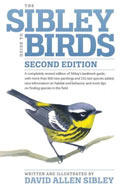 The Sibley Guide to Birds, Second Edition
The Sibley Guide to Birds, Second Edition
The first edition of David Allen Sibley’s Guide to Birds came out in 2000 and was immediately hailed as a monumental achievement in the world of field guides: well over 6000 paintings showing all the birds of North America perched and in flight, in juvenile and adult, male and female, breeding and nonbreeding plumages—all by a single artist. Since then there has been a long wait for a revised edition, both for the standard reasons why bird guides are updated (to keep up with changes in bird taxonomy and to update range maps) and because people were eager to see how the incumbent grandmaster of bird illustration would improve his masterwork. More than any other current bird book, the Sibley Guide is the execution of one man’s personal vision and a new edition is therefore regarded as not merely a technical revision, but a new artistic statement.
So, beyond the expected updating of names and maps, what has changed? 600 new paintings have been added, many of them covering 111 added rare species. All the illustrations are now 15 to 20 percent larger than the first edition. Nearly all images appear darker and more saturated than in the older book. This has not been greeted with universal acclaim (many birds appear darker than they “typically” appear), but it is unlikely to cause many practical difficulties in identification and a strong artistic case can be made for the rich, vivid colors of the new edition. While the artwork remains the focus of the book, the second edition also adds a significant amount of new words, nearly all of which are helpful. Some things are minor (Sibley’s trademark family overview pages with small illustrations showing genus/family relationships are now helpfully cross-referenced with page numbers for the species accounts), while others go a long way towards filling out the sparse text of the first edition. Now every species has a few lines on habitat preferences and abundance, while hundreds of helpful notes on identification and behavior are liberally inserted throughout. The “Big Sibley” has gotten a little bigger—and consolidated its position as the most comprehensive illustrated bird guide available.
- Go to the index of book reviews -
5/16/13: Birds of Napa County
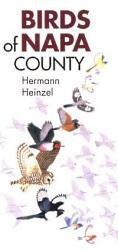 When it comes to identifying local birds we are often confronted with an overwhelming number of books from various publishers. Often bulky and overwhelming to the beginner, it can be a daunting task discerning which guide to purchase. Birds of Napa County by Hermann Heinzel is a handy resource that offers complete coverage of not only the Napa region but all of Northern California as well. Although a few oceanic species such as petrels, murrelets, etc. are not included this is still a must have book. The concise text though brief is complimented by excellent color illustrations. Its most outstanding feature however is portability. It slips handily into a shirt pocket for quick and ready access.
When it comes to identifying local birds we are often confronted with an overwhelming number of books from various publishers. Often bulky and overwhelming to the beginner, it can be a daunting task discerning which guide to purchase. Birds of Napa County by Hermann Heinzel is a handy resource that offers complete coverage of not only the Napa region but all of Northern California as well. Although a few oceanic species such as petrels, murrelets, etc. are not included this is still a must have book. The concise text though brief is complimented by excellent color illustrations. Its most outstanding feature however is portability. It slips handily into a shirt pocket for quick and ready access.
With a modest price tag and over 300 species described and illustrated it's a satisfying feeling to know that this little book will help you identify practically every species you encounter no matter where you live or travel in Northern California. - Don
* * *
Smallness can have a lot of benefits in a field guide: Birds of Napa County is lightweight and portable, relatively cheap, and most importantly accessible. The latest edition of the National Geographic Field Guide to Birds contains 990 species; Birds of Napa County covers a little over 300. For beginners, the main function of the additional 700 species found in a complete guide will be to cause confusion—it’s easier to identify a new bird when presented with three possibilities (one or two of which you may be familiar with already), than with seven. Produced by Heyday Books of Berkeley, the non-profit publisher of the Laws Guide to the Sierras and other California specialties, this is as local of a bird book as you are likely to find.
The other standout feature of this book is its artwork. While some guides, such as the technically impeccable and hugely popular Sibley, feature birds lined up in easily compared rows, extracted onto white backgrounds, Hermann Heinzel opts for a more personal and engaging style, with paintings of birds often including bits of habitat or depicting unique behaviors. Sometimes this is of direct use in identification, such as when he shows a Red-shouldered Hawk perching on a telephone wire, with the Red-tailed Hawk on the opposite page perched on the pole instead. The preference of perching site for each of these two birds is a pretty reliable indicator of which species to expect. But even beyond direct utility in identification, this style of drawing creates a much more fun browsing experience: watch a Pygmy Owl chase a terrified chickadee, see a Pileated Woodpecker feed its begging nestlings, chuckle at the upside down White-breasted Nuthatch, and appreciate how the Marsh Wren is shown in a marsh, the Rock Wren among rocks, and the Hooded Oriole in a palm. - Jack
- Go to the index of book reviews -
7/18/12: Stokes Field Guide to the Birds of North America
Review by Don Kimball
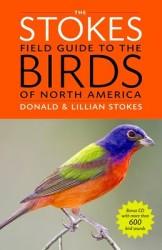
Well-known authors Don and Lillian Stokes have outdone themselves with this excellent volume covering over 854 species in North America. This is by far the most thorough and comprehensive field guide using photographs of any North American guide published to date. Serious birders will be happy to note that recent splitting of species (ie. Pacific Wren/Winter Wren) are also included. Not only are most of the images crisp and well lit, the Guide covers many plumages as well. From adult breeding to wintering and first year birds, the reader is less likely to be left puzzled by differences in feather detail. Most species are illustrated both at rest and in flight including many species of songbirds! Non-breeding rarities are included as are introduced and established feral populations of non-natives. The text though brief, is concise and helpful covering shape, varieties in plumages, habitat and voice. Each species is also accompanied by highly useful range maps which illustrate summer, winter, and year-round range. Migration routes and areas of limited occurrence are also included. For those wanting to acquire more I.D. skills through bird song, a handy CD comes tucked in the back of the guide containing 150 common songs plus 600 other calls.
This is a valuable addition to any birding library but this guide is not designed to replace the pocket guide you may be using in the field. At 3.04 lbs it is a bit heavy for most users in that respect. However this richly illustrated volume is invaluable as a resource to be kept in a vehicle for quick reference, or used at home where one can pore over the many excellent bird images. Rather than replacing the more traditional field guides which use color plates for reference, the Stokes guide compliments them in an extremely helpful manner, providing the reader with additional tools for identification. Richly illustrated with over 3400 images, this is an excellent addition to any birding library and definitely a must-have book on identification. It is little wonder that online reviewers have rated this book with 5 stars!
- Go to the index of book reviews -
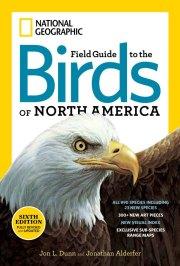 1/20/12: National Geographic Field Guide to Birds
1/20/12: National Geographic Field Guide to Birds
Review by Scott Carey
Every year the number of bird field guides seems to grow. Though this can only be a good thing, it’s good to see that the stable field guides are still some of the best. The “National Geographic Field Guide to the Birds of North America” is now in its sixth edition since it first came out in the mid-eighties. The sixth edition has added 300 art pieces, has a total of 990 species with 23 being new to this edition. In addition this edition includes more information on subspecies and has updated the newest information on split species or taxonomy changes. Although this may be more information than a beginner birdwatcher may want or need, that same birdwatcher will appreciate the lay out of the book, including the quick-find index tabs, which are very helpful for the beginning birdwatcher to learn about the families of birds that all birdwatchers should know.
Though most of the artwork has always been excellent and accurate, some plates from the older editions could have been better. With this edition, all the plates are revised and accurate for the birds. Besides the artwork, the identification text and range maps add up to make this one of the top field guides available today.
- Go to the index of book reviews -
5/14/11: Birds of Western North America: A Photographic Guide
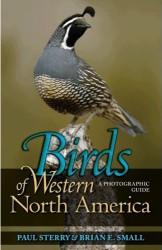 Paul Sterry & Brian E. Small. Princeton, 2009
Paul Sterry & Brian E. Small. Princeton, 2009
The Good: Less than two years old, the photographs in this book are sharp and modern looking, generously sized, and often rather beautiful. “Preference has been given to photographs that serve both to illustrate key identification features and to emphasize the beauty of the bird in question” reads the introduction, and it is that second goal which really makes this book stand out. The text is generally solid, the book's design is attractive, and the coverage is fairly comprehensive, with most important plumages displayed.
The Bad: While both text and photos are generally solid, neither achieves the comprehensiveness of the Big Stokes as an identification tool.
The Verdict: This is the most beautiful of the photographic field guides and offers the most purely aesthetic satisfaction for armchair birders. The limitation to western birds and sensible text makes this an approachable and enjoyable field guide, completely appropriate for beginners, but still comprehensive enough to satisfy most birders’ needs.
- Go to the index of book reviews -
11/21/10: Lone Pine's Birds of Northern California
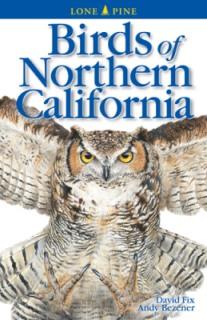
There are a lot of field guides out there—and we have most of them. Some are targeted to a very small geographical area (Marin County, or the Bay Area). Others include all of the birds you are likely to encounter throughout North America. Lone Pine’s Birds of Northern California by David Fix and Andy Bezener provides an excellent balance: it can easily be used by beginners, but it contains enough species and identification information that it won’t be quickly outgrown as you learn more.
For beginners, the most challenging part of using a field guide is often the sheer number of species. This book keeps things manageable by limiting its selection to the birds of Northern California and by only listing one bird per page. One “quick fix” offered by some beginners’ guides is to arrange species by color; while this may seem like a good idea at first, it really isn’t. Many birds do not fit neatly under a single color heading and, more importantly, this kind of arrangement promotes random flipping through the field guide. The Lone Pine book organizes species based on evolutionary development—as do all more advanced field guides. Learning to understand this arrangement with a simpler book will help you to understand the relationships between different taxonomic groups and prepare you to use more complete field guides, should you ever decide to upgrade.
But there are several reasons why Lone Pine’s field guide won’t be quickly outgrown. 328 species are included—far more than introductory guides to so-called backyard birds (which have their place as well). Dedicating a full page to each bird allows room for a large illustration, clear range map, and plenty of information. One feature particularly useful for new birders is the extensive comparisons offered between similar species. Most advanced field guides assume comfort with identifying and comparing the most relevant field marks, but it can be very helpful to have this information in one handy place when choosing between two equally-unfamiliar species. The other stand out feature of Birds of Northern California is the paragraph of natural history, anecdotes, etymology, conservation issues, and general trivia offered for each bird. This information is always enjoyable to read and can help give you an immediate “feel” for a bird.
- Go to the index of book reviews -

